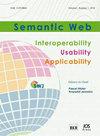在本体驱动的社会技术系统中,以用户为中心的工程解释查询答案
IF 2.9
3区 计算机科学
Q2 COMPUTER SCIENCE, ARTIFICIAL INTELLIGENCE
引用次数: 3
摘要
在过去的几年里,随着基于人工智能的解决方案出现在越来越多的应用程序中,解释在智能系统中的作用已经成为人们关注的焦点。虽然数据驱动(或机器学习)技术经常被用作不透明(也称为黑箱)方法如何导致偏见和普遍缺乏可解释性和可解释性等问题的例子,但实际上,这些特征通常很难被驯服,即使是基于通常被认为更容易接受的工具的方法,如基于知识的形式化。在本文中,我们继续研究和开发构建工具,以促进可解释和可解释混合智能社会技术系统的实现,重点关注用户可以利用的功能,以构建对其查询的解释。特别是,我们提出了一个最近提出的应用程序框架的实现(并提供其源代码),用于开发这样的系统,并探索以用户为中心的机制,基于所需的解释类型(如反事实、上下文等)和用于构建它们的输入(来自各种来源,如知识库和低级数据驱动模块)来构建解释。为了验证我们的方法,我们开发了两个用例,一个作为检测社交平台上的仇恨言论的运行示例,另一个作为考虑网络欺凌场景的扩展。本文章由计算机程序翻译,如有差异,请以英文原文为准。
Engineering user-centered explanations to query answers in ontology-driven socio-technical systems
The role of explanations in intelligent systems has in the last few years entered the spotlight as AI-based solutions appear in an ever-growing set of applications. Though data-driven (or machine learning) techniques are often used as examples of how opaque (also called black box) approaches can lead to problems such as bias and general lack of explainability and interpretability, in reality these features are difficult to tame in general, even for approaches that are based on tools typically considered to be more amenable, like knowledge-based formalisms. In this paper, we continue a line of research and development towards building tools that facilitate the implementation of explainable and interpretable hybrid intelligent socio-technical systems, focusing on features that users can leverage to build explanations to their queries. In particular, we present the implementation of a recently-proposed application framework (and make available its source code) for developing such systems, and explore user-centered mechanisms for building explanations based both on the kinds of explanations required (such as counterfactual, contextual, etc.) and the inputs used for building them (coming from various sources, such as the knowledge base and lower-level data-driven modules). In order to validate our approach, we develop two use cases, one as a running example for detecting hate speech in social platforms and the other as an extension that also contemplates cyberbullying scenarios.
求助全文
通过发布文献求助,成功后即可免费获取论文全文。
去求助
来源期刊

Semantic Web
COMPUTER SCIENCE, ARTIFICIAL INTELLIGENCEC-COMPUTER SCIENCE, INFORMATION SYSTEMS
CiteScore
8.30
自引率
6.70%
发文量
68
期刊介绍:
The journal Semantic Web – Interoperability, Usability, Applicability brings together researchers from various fields which share the vision and need for more effective and meaningful ways to share information across agents and services on the future internet and elsewhere. As such, Semantic Web technologies shall support the seamless integration of data, on-the-fly composition and interoperation of Web services, as well as more intuitive search engines. The semantics – or meaning – of information, however, cannot be defined without a context, which makes personalization, trust, and provenance core topics for Semantic Web research. New retrieval paradigms, user interfaces, and visualization techniques have to unleash the power of the Semantic Web and at the same time hide its complexity from the user. Based on this vision, the journal welcomes contributions ranging from theoretical and foundational research over methods and tools to descriptions of concrete ontologies and applications in all areas. We especially welcome papers which add a social, spatial, and temporal dimension to Semantic Web research, as well as application-oriented papers making use of formal semantics.
 求助内容:
求助内容: 应助结果提醒方式:
应助结果提醒方式:


